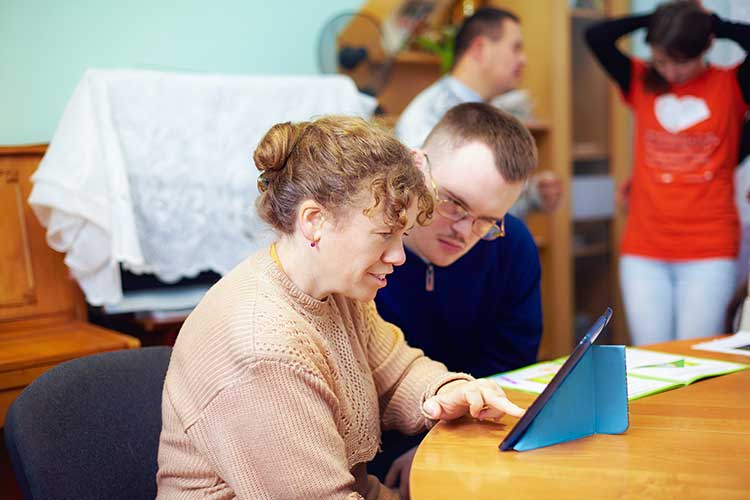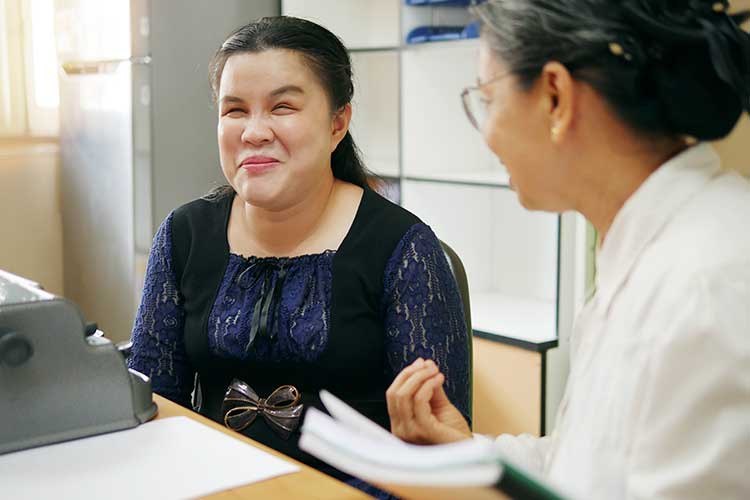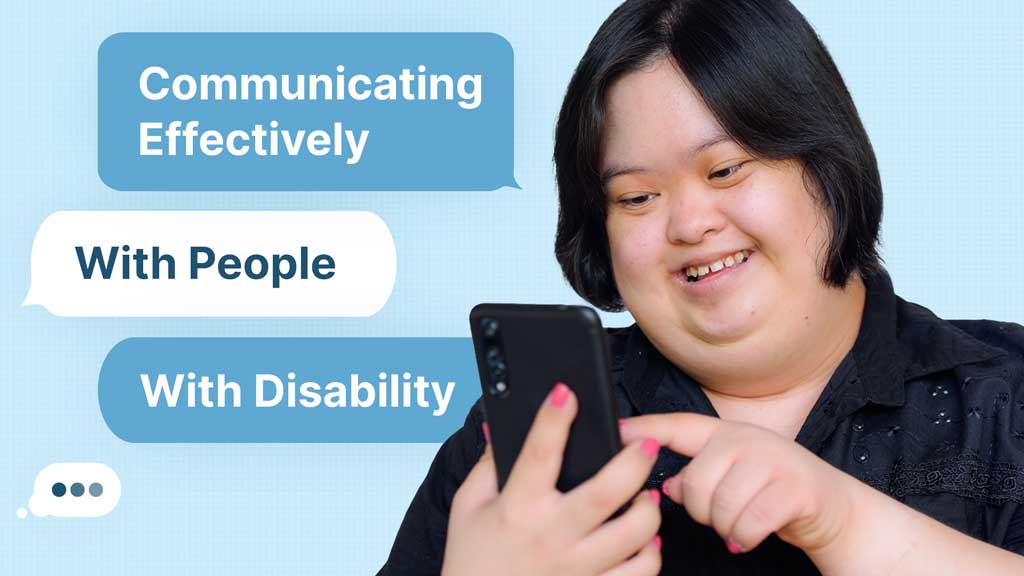Content warning: Please be aware that this article contains ableist and offensive language.
Being able to communicate freely is a fundamental human right that allows people to work, form relationships and seek support (Queensland Government 2018; Steel 2018).
Every person, including those with disability, has the right to express their feelings, needs and wants, and to communicate with other people - irrespective of speech ability or cognition (Queensland Government 2018; Steel 2018).
Despite this, people with disability may face barriers to communication that make it difficult for them to take part in everyday life and be included in society (Steel 2018).
In addition to providing appropriate support to help people with disability communicate (if required), the attitudes and approaches of those communicating with them - such as family members, friends, carers and healthcare professionals - are also important in ensuring that people with disability are able to exercise their fundamental rights.
Effective and empathetic communication is related to both how you talk to someone and the words you use to do so.

Using Appropriate Terminology and Inclusive Language
Language is a powerful tool. The choices that people make about language affect not only how people with disability feel but also how society perceives them (PWDA 2021).
Using disrespectful, disempowering and discriminatory language causes hurt, excludes people, poses a barrier to participation in society and reinforces stereotypes (PWDA 2021).
In our day-to-day lives - and especially when talking to, referring to or working with people with disability - we need to be aware of the words we choose and the meanings behind them (PWDA 2021).
Identity-first and Person-first Language
There are two ways in which people with disability can be referred to:
- Identity-first language puts the identifier before the person (e.g. ‘autistic person’)
- Person-first language puts the person before the identifier (e.g. ‘person with cerebral palsy’).
(PWDA 2021)
Each person has a preference for the language they use to describe themself and their disability, and it’s important to listen to and affirm their choices (PWDA 2021).
Person-first language is widely used by governments and organisations in Australia due to the idea that a person’s disability should not be focused on unnecessarily. However, some people prefer identity-first language as it indicates that while their disability is not something they can control, they are embracing this part of their identity. Certain Autistic and Deaf communities prefer identity-first language, for example (PWDA 2021).
The best way to find out how someone would like to be described is to ask them (CDC 2020).
Avoiding Stereotypes
Stereotyping denies the individuality of people with disability and can lead to discrimination. The following are harmful and untrue stereotypes about people with disability:
- Having a disability is a tragedy
- People with disability should be pitied
- People with disability are superhuman or extraordinary for living their lives
- Family, partners and friends of those with disability are heroic, brave or inspiring
- All people with disability are asexual.
(QLD Gov 2012)
Inspiration Objectification
The term inspiration objectification (also known as ‘inspiration porn’), which was created by late Australian disability activist Stella Young, describes the way in which people with disability are often portrayed as ‘inspirational’ simply for existing. These portrayals serve to inspire people without disability to be grateful for their own lives and think, ‘Well, however bad my life is, it could be worse - I could be that person’ (PWDA 2021; Young 2014).
This type of thinking is hurtful to people with disability and objectifies their existence for the benefit of non-disabled people. If a person with disability achieves something newsworthy, this of course deserves celebration - but participating in a mundane or everyday activity is not extraordinary just because that person has disability (PWDA 2021; Young 2014).
Implying that a person with disability is brave, special or inspirational for simply living their life is patronising and offensive (AFDO 2023).
Terms to Use and Avoid
The following table from People With Disability Australia’s What Do I Say? A Guide to Language About Disability resource provides general guidance on terms to avoid and recommended alternatives to use when talking to and about people with disability. (Note that this is not a comprehensive list.)
| Use | Avoid |
|---|---|
|
|
|
|
|
|
|
|
|
|
|
|
|
|
|
|
|
|
(Adapted from PWDA 2021)
Communicating with People with Disability
Some people find it daunting to communicate with a person with disability. Common concerns include:
- Not knowing what terminology to use
- Not wanting to offend or embarrass the person
- Not wanting to say or do the wrong thing
- Being unfamiliar with appropriate communication strategies.
(NDCO 2016; ANU 2024)
While these concerns may come from a place of good intentions, they are unnecessary and might only end up creating barriers instead of reducing them. Using correct and respectful terminology is important, but don’t be so afraid to make a mistake that you avoid saying anything at all. Instead, remember to treat all people with the respect they deserve, be willing to listen and learn, and apologise if you make a mistake (ANU 2024).
General Communication Tips
- Talk to people with disability like you would any other person. Use an age-appropriate tone and treat adults like adults.
- Speak directly to the person instead of their carer, interpreter or others present.
- Be polite and patient.
- Avoid raising your voice.
- Avoid making assumptions about the person’s disability.
- Avoid focusing on the person’s disability unnecessarily, but don’t be afraid to refer to it either.
- Empathise if appropriate.
- Don’t pretend to understand what the person is saying if you don’t; if you’re having difficulty understanding, let them know.
- Try rewording instead of repeating if the person is having difficulty understanding you.
- Ask the person if they would like help before offering assistance. Respect the person’s wishes if they reject your offer - your help may not be wanted or needed.
- Never touch or distract an assistance dog that is working.
(AFDO 2018; Queensland Government 2018; ANU 2024; Maroondah City Council 2011; NDCO 2016)
Communicating with a Person with Physical Disability
- Never touch, push or move a person’s mobility aid without permission
- If the person uses a wheelchair, sit down so that you can communicate at eye level.
(AFDO 2018)
Communicating with a Person Who has a Vision Impairment

- When you meet someone with a vision impairment, address them by name and introduce yourself by name, even if you know each other
- Verbalise your thoughts and feelings
- Let the person know if you are leaving or entering the room
- Be specific when giving directions or instructions (e.g. ‘slightly to your right’ instead of ‘over there’)
- It’s fine to use phrases like ‘see you soon’
- If the person requests assistance to move somewhere, offer your elbow or shoulder to guide them.
(AFDO 2018; AND 2024; NDCO 2016)
Communicating with a Person Who has a Hearing Impairment
- Before speaking, get the person’s attention by gently tapping their shoulder or waving
- Face the person and maintain eye contact
- Keep your mouth visible when speaking and avoid exaggerating your mouth movements
- Avoid speaking too quickly or slowly
- Use short sentences
- Speak at a normal volume
- Use a pen and paper to communicate if necessary
- It’s fine to use phrases like ‘did you hear about...’
(AFDO 2018; NDCO 2016)
Communicating with a Person with Intellectual Disability
- Before speaking, get the person’s attention by using their name or making eye contact
- Keep your questions and answers simple and easy to understand
- Consider your body language, as the person may rely on visual cues
- Communicate using visual aids (e.g. diagrams or pictures) if required
- Be specific and direct, avoiding abstracts, acronyms, metaphors or puns
- Be prepared to repeat or rephrase information if necessary.
(AFDO 2018; NDCO 2016)
Communicating with a Person with Speech Disability
- Understand that speech is just one way to communicate - non-verbal cues such as gestures, facial expressions and body language can also be used
- Be patient and avoid finishing the person’s sentences for them
- Give the person your undivided attention
- Reduce background noise and distractions
- Use facial expressions and gestures to convey information
- Give the person enough time to respond to you and be comfortable with silence
- Show active listening by making sounds of acknowledgement such as ‘yes’ and ‘mhm’
- If the person uses a communication device (e.g. manual or electronic communication board), ask them the best way to use it.
(Steel 2018; Smeltzer et al. 2017)
Test Your Knowledge
Question 1 of 3
Which one of the following is an example of identity-first language?
Topics
References
- Australian Federation of Disability Organisations 2018, Communication With People With Disabilities, AFDO, viewed 2 September 2024, https://www.afdo.org.au/resource-communication-with-people-with-disabilities/
- Australian Federation of Disability Organisations 2023, Language Guide, AFDO, viewed 2 September 2024, https://www.afdo.org.au/news/language-guide/
- Australian National University 2024, Communication & Etiquette, ANU, viewed 2 September 2024, https://services.anu.edu.au/human-resources/diversity-inclusion/disability-communication-etiquette/communication-etiquette
- Centers for Disease Control and Prevention 2022, Communicating With and About People with Disabilities, U.S. Department of Health & Human Services, viewed 30 August 2024, https://www.cdc.gov/ncbddd/disabilityandhealth/materials/factsheets/fs-communicating-with-people.html
- Maroondah City Council 2011, Communicating With People With a Disability, Victoria State Government, viewed 2 September 2024, https://www.maroondah.vic.gov.au/Community-support-business/Disability-services/Disability-publications
- National Disability Coordination Officer Program 2016, Communicating Effectively With People With Disabilities, NDCO, viewed 2 September 2024, https://www.westernsydney.edu.au/__data/assets/pdf_file/0009/887931/NDCO_Communicating_effectively.pdf
- People With Disability Australia 2021, What Do I Say? A Guide to Language About Disability, PWDA, viewed 2 September 2024, https://pwd.org.au/wp-content/uploads/2021/12/PWDA-Language-Guide-v2-2021.pdf
- Queensland Government 2012, A Way With Words: Guidelines for the Portrayal of People With a Disability, Queensland Government, viewed 2 September 2024, https://www.qld.gov.au/__data/assets/pdf_file/0021/58107/way-with-words.pdf
- Queensland Government 2018, Better Communication, Queensland Government, viewed 30 August 2024, https://www.qld.gov.au/disability/community/communicating
- Smeltzer, SC, Mariani, B & Meakim, C 2017, Communicating with People with Disabilities, Villanova University College of Nursing, viewed 2 September 2024, http://www.nln.org/professional-development-programs/teaching-resources/ace-d/additional-resources/communicating-with-people-with-disabilities
- Steel, J 2018, ‘How to Improve Communication for People With Disabilities’, The Conversation, 30 August, viewed 30 August 2024, https://www.sbs.com.au/news/insight/how-to-improve-communication-for-people-with-disabilities
- Young, S 2014, Inspiration Porn and the Objectification of Disability: Stella Young at TEDxSydney 2014, online video, 14 May, viewed 2 September 2024, https://www.youtube.com/watch?v=SxrS7-I_sMQ
 New
New 
